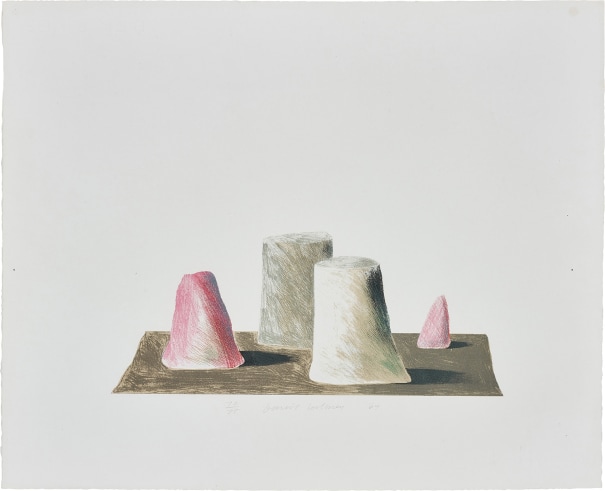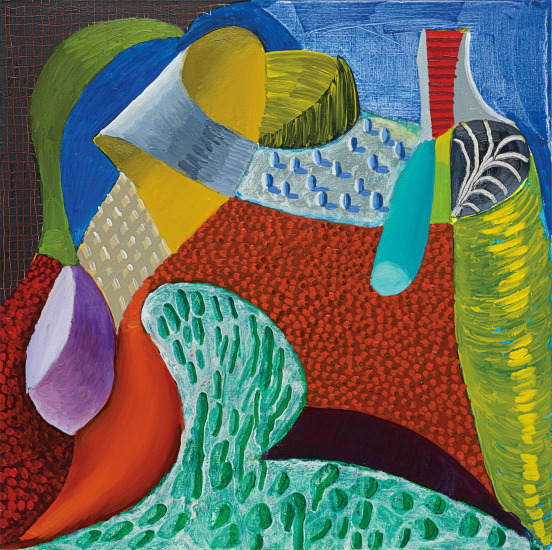◆ 23 David Hockney Follow Bridlington Violets signed, titled and dated 'David Hockney "Bridlington Violets" 1989' on the reverse oil on canvas 35.6 x 45.7 cm (14 x 18 in.) Painted in 1989.
Provenance André Emmerich Gallery, New York Nishimura Gallery, Toyko Jonathan Novak Contemporary Art, Los Angeles Private Collection, Florida Private Collection, Los Angeles (acquired from the above in 2001) Exhibited Tokyo, Nishimura Gallery, David Hockney Paintings - Flower, Chair, Interior , 23 October - 25 November 1989, no. 12, n. p. (illustrated) Los Angeles, L.A. Louver Gallery; Honolulu, The Contemporary Museum, David Hockney 72 New Pictures , 6 December 1989 - 19 March 1990, pl. 17 (illustrated) Catalogue Essay ‘I draw flowers every day and send them to my friends so they get fresh blooms every morning.’ David Hockney Painted in 1989, the same year as David Hockney’s acclaimed travelling retrospective at the Los Angeles County Museum of Art, the Metropolitan Museum of Art, New York and Tate Gallery, London, Bridlington Violets represents a masterful example of Hockney’s paintings from the 1980s and 1990s, when the artist developed a broader pre-occupation with the experience of painting from life. Characterised by the colliding of flatness in the violet hues with the illusion of spatial depth in the deep evergreen shadows and cerulean blue cast on a white tablecloth, the present work exemplifies Hockney’s eye for veracity in seemingly mundane subjects. A vibrant yellow backdrop rendered with short horizontal strokes stacked atop each other stabilises the composition, allowing the central purple flowers to visually pop off the canvas. Bridlington Violets exemplifies the artist’s investigation of non-perspective, a composition that is bereft of any one single vantage point. As the artist expanded in 1984, his painting ‘comes closer to how we actually see - which is to say, not all at once but in discrete, separate glimpses which we then build up into our continuous experience of the world’ (David Hockney quoted in Lawrence Weschler, “True to Life,” The New Yorker , July 9, 1984, p. 62) For Hockney, flowers began as decorative punctuations amid an interior scene, as can be seen in his earlier paintings from the 1970s such as Mr. and Mrs. Clark and Percy (1970-71, Tate, London) in which a floral arrangement of white lilies sits in a vase on a small table to the right of the figures. Slowly advancing from ornamental floral arrangements to central motifs, flowers began to dominate the artist’s compositions, as can be seen in the present work. Throughout art history, flowers have remained a traditional focus for all painters from the Dutch Old Masters to the Post-Impressionist masters and to Pop Art innovators. Hockney’s dedication to the purist depiction of six purple violets clearly pays homage to the master of still-life and landscape, Vincent van Gogh The work draws direct visual reference to van Gogh’s dazzling Sunflowers , which was painted a century prior to Hockney’s still life. Expressing his admiration for the influential Dutch Post-Impressionist painter, Hockney commented, ‘I’ve always had quite a passion for van Gogh, but certainly from the early seventies it grew a lot, and it’s still growing. I became aware of how wonderful [his paintings] really were. Somehow they became more real to me…it is only recently they’ve really lived for me’ (David Hockney quoted in Marco Livingstone, David Hockney , New York, 1997, p. 149). Despite the absence of a human presence, this work represents a different kind of portraiture for Hockney. Distilled within the boundaries of the picture frame, the central purple violets are rendered in the artist’s painterly use of light and shadow, capturing a fleeting moment in time. Painted in Bridlington, the Yorkshire coastal town where Hockney has a studio, Bridlington Violets arrests the small, natural flowers within a man-made interior, calling upon vanitas and memento mori pictures of the past. As such, this work specifically highlights Hockney’s extraordinary ability to create bright and warm paintings by sealing the subject matter in a moment of corporeal glory and blooming celeb
◆ 23 David Hockney Follow Bridlington Violets signed, titled and dated 'David Hockney "Bridlington Violets" 1989' on the reverse oil on canvas 35.6 x 45.7 cm (14 x 18 in.) Painted in 1989.
Provenance André Emmerich Gallery, New York Nishimura Gallery, Toyko Jonathan Novak Contemporary Art, Los Angeles Private Collection, Florida Private Collection, Los Angeles (acquired from the above in 2001) Exhibited Tokyo, Nishimura Gallery, David Hockney Paintings - Flower, Chair, Interior , 23 October - 25 November 1989, no. 12, n. p. (illustrated) Los Angeles, L.A. Louver Gallery; Honolulu, The Contemporary Museum, David Hockney 72 New Pictures , 6 December 1989 - 19 March 1990, pl. 17 (illustrated) Catalogue Essay ‘I draw flowers every day and send them to my friends so they get fresh blooms every morning.’ David Hockney Painted in 1989, the same year as David Hockney’s acclaimed travelling retrospective at the Los Angeles County Museum of Art, the Metropolitan Museum of Art, New York and Tate Gallery, London, Bridlington Violets represents a masterful example of Hockney’s paintings from the 1980s and 1990s, when the artist developed a broader pre-occupation with the experience of painting from life. Characterised by the colliding of flatness in the violet hues with the illusion of spatial depth in the deep evergreen shadows and cerulean blue cast on a white tablecloth, the present work exemplifies Hockney’s eye for veracity in seemingly mundane subjects. A vibrant yellow backdrop rendered with short horizontal strokes stacked atop each other stabilises the composition, allowing the central purple flowers to visually pop off the canvas. Bridlington Violets exemplifies the artist’s investigation of non-perspective, a composition that is bereft of any one single vantage point. As the artist expanded in 1984, his painting ‘comes closer to how we actually see - which is to say, not all at once but in discrete, separate glimpses which we then build up into our continuous experience of the world’ (David Hockney quoted in Lawrence Weschler, “True to Life,” The New Yorker , July 9, 1984, p. 62) For Hockney, flowers began as decorative punctuations amid an interior scene, as can be seen in his earlier paintings from the 1970s such as Mr. and Mrs. Clark and Percy (1970-71, Tate, London) in which a floral arrangement of white lilies sits in a vase on a small table to the right of the figures. Slowly advancing from ornamental floral arrangements to central motifs, flowers began to dominate the artist’s compositions, as can be seen in the present work. Throughout art history, flowers have remained a traditional focus for all painters from the Dutch Old Masters to the Post-Impressionist masters and to Pop Art innovators. Hockney’s dedication to the purist depiction of six purple violets clearly pays homage to the master of still-life and landscape, Vincent van Gogh The work draws direct visual reference to van Gogh’s dazzling Sunflowers , which was painted a century prior to Hockney’s still life. Expressing his admiration for the influential Dutch Post-Impressionist painter, Hockney commented, ‘I’ve always had quite a passion for van Gogh, but certainly from the early seventies it grew a lot, and it’s still growing. I became aware of how wonderful [his paintings] really were. Somehow they became more real to me…it is only recently they’ve really lived for me’ (David Hockney quoted in Marco Livingstone, David Hockney , New York, 1997, p. 149). Despite the absence of a human presence, this work represents a different kind of portraiture for Hockney. Distilled within the boundaries of the picture frame, the central purple violets are rendered in the artist’s painterly use of light and shadow, capturing a fleeting moment in time. Painted in Bridlington, the Yorkshire coastal town where Hockney has a studio, Bridlington Violets arrests the small, natural flowers within a man-made interior, calling upon vanitas and memento mori pictures of the past. As such, this work specifically highlights Hockney’s extraordinary ability to create bright and warm paintings by sealing the subject matter in a moment of corporeal glory and blooming celeb
.jpg)
.jpg)



.jpg)
.jpg)
.jpg)
.jpg)
.jpg)

Try LotSearch and its premium features for 7 days - without any costs!
Be notified automatically about new items in upcoming auctions.
Create an alert